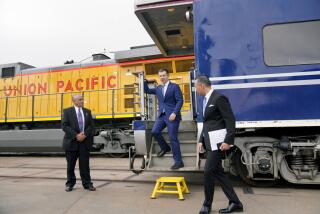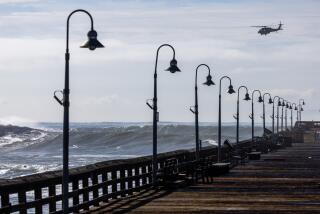Full Speed Ahead for Tiny Port
Jess Herrera has spent much of his adult life working at the Port of Hueneme and has watched it grow from a sleepy lagoon to an economic powerhouse that generates an estimated $450 million each year for Ventura County’s economy.
As a harbor commissioner who also works as a unionized marine clerk, Herrera said the only deep-water shipping center between Los Angeles and San Francisco has shed its boom-or-bust past and is on track for steady growth in the future.
“Trade is the No. 1 business in the world, and we’re doing it right here in Ventura County,” said Herrera, 54, the commission’s vice president who has been at the harbor for 35 years. “We take a lot of pride in our port.”
As the tiny port celebrates its 65th anniversary this week, it continues working to bolster trade overseas, find ways to expand limited facilities and increase efficiency. In fact, port officials have been busy laying the groundwork for growth--supporting several big contracts with importers, strengthening ties with China and arranging an extensive dredging project that will accommodate larger ships for decades.
The secret of the port’s success, according to port executive director William J. Buenger, is its close relationship with the tenants and shipping lines that use the two-wharf, five-berth facility.
“It’s a very strong cadre of world-class customers that I believe are going to be here for a long time to come,” he said. “They’ve invested a lot of money in private facilities, and that’s better than any contract you could write.”
Unlike much larger ports in Los Angeles County, the Port of Hueneme specializes in items such as automobiles, fresh fruit and produce that aren’t transported in shipping containers--the 40-foot boxes that attach directly to trucks.
This strategy has been profitable. The number of vehicles shipped through the port more than doubled in the last decade, and the import of bananas and export of citrus during that time jumped nearly 242%. Harbor district revenue from operations climbed from $3.7 million in fiscal year 1990-1991 to $8.3 million last year, while net income during that time grew more than five times to $1.1 million.
But to maintain such momentum the port must find room to grow beyond its 135 acres.
Two years ago, the port began a licensing agreement with the Navy to allow the port to use a Navy-owned wharf adjacent to the port’s north terminal. After Sept. 11, commercial use of that wharf was curtailed, but Buenger said the port hopes to resume use of the dock space and expand the deal to include more storage area. Herrera said he is confident an enhanced alliance can be worked out with Navy officials.
Until then, the port is making steady gains elsewhere. It spent $3.9 million to buy 12 acres at its northeast corner that once held an old Sunkist shed that will be converted into additional automobile storage.
Pacific Vehicle Processors--which gets Jaguars, Land Rovers, Mitsubishis, Suzukis and Volvos ready for market--recently announced a contract with Volkswagen-Audi that will nearly double the size of its operation. The company will handle imports of 100,000 extra cars next year, which will eventually result in the hiring of 250 additional workers.
“The port is going to have to develop more land in order for us to bring in more business,” said James J. Kilpatrick, the company’s vice president of marketing and development.
Pacific Vehicle’s off-site location, along Hueneme Road east of the port, will also grow from its current 65 acres to 130 acres, including 38 acres it’s buying at the end of Saviers Road and other property it leases from Southern California Edison and the port.
To further prepare for its expansion, the port is counting on a $6.1-million extension of Rice Avenue to connect it to Hueneme Road, which could begin construction by spring 2003. There is also a planned $6.8-million widening of Hueneme Road to accommodate more traffic and a dredging project to make the port’s single channel 5 feet deeper.
But today, harbor officials are taking a breather to celebrate where the port has come from since it became a legal entity in May 1937. The Hueneme Lagoon was dug out to form the commercial port over a period of several years.
Linked to National Maritime Month, about 750 schoolchildren are set to take tours this morning, and there will be a public open house from 4 to 7:30 p.m. featuring a barbecue, an automobile display and viewing of the Lane Victory, a World War II cargo vessel.
The ship, restored and staffed by a crew of retired merchant marine seamen in their 70s and 80s, was built in Wilmington and made its first cruise up the coast to the Port of Hueneme to pick up a load of munitions and supplies destined for the Pacific in the last months of the war.
*
*--* Port Profits Year Operating Revenue Net Income 1990-91 $3,776,700 $222,211 1991-92 $4,450,377 $512,906 1992-93 $5,111,338 $719,207 1993-94 $6,138,142 $766,224 1994-95 $7,238,233 $713,648 1995-96 $6,557,672 $625,881 1996-97 $6,179,107 - $14,472 1997-98 $7,346,628 $913,849 1998-99 $7,374,473 $944,254 1999-2000 $8,851,463 $1,654,543 2000-01 $8,315,895 $1,143,802 2001-02* $8,568,040 $958,591 * Projected
*--*
*
*--* Cargo Volume Goods are measured in metric revenue tons, which are either 1 cubic meter in volume or 1,000 kilograms in weight. An automobile counts as one metric ton 1990-91 535,821 m.t 1991-92 478,384 m.t 1992-93 627,742 m.t 1993-94 790,675 m.t 1994-95 986,914 m.t 1995-96 960,464 m.t 1996-97 805,869 m.t 1997-98 1,028,448 m.t 1998-99 1,200,702 m.t 1999-2000 1,117,738 m.t 2000-01 1,157,891 m.t 2001-02* 1,055,170 m.t * Projected
*--*


